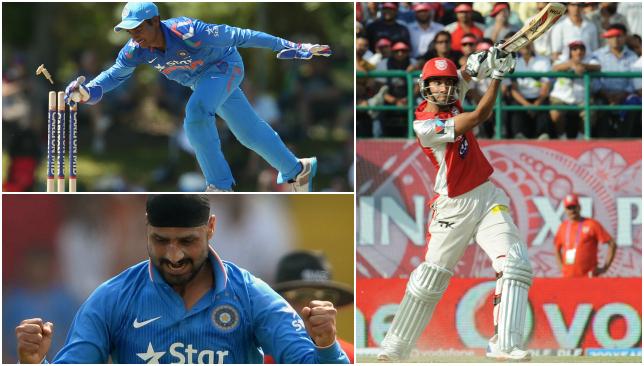
A two-faced persona of Indian cricket has emerged in recent times. On the one hand, the tried and tested cricketers have been persisted with time and again, even welcomed back after years in the wilderness. On the other, the hopefuls for the future have largely been given the cold shoulder. Selective patience has been the order of the day. For players who lie outside the core group of cricketers, chances to impress have come at a premium — and almost every such break has an air of finality to it.
Parvez Rasool, for instance, was tried out in one low-key match last year and has not been in contention since. Some players, such as Rishi Dhawan in the past and Gurkeerat Singh Mann in the latest series against South Africa, were selected in various squads but never fielded. Veteran spinner Harbhajan Singh, meanwhile, was not only recalled after three years but also played for India in all three formats in 2015. It is one thing to struggle to break into the starting XI due to fierce competition within the ranks but an altogether different one to keep missing out due to a captain’s aversion towards experimentation.
Cast your mind back to the World Cup earlier this year. Skipper MS Dhoni used only 12 players, the lowest by any captain, across India’s eight matches. In fact, he would’ve probably used only 11 had Mohammed Shami not picked up a knock. Even against Zimbabwe in the final group game, when Dhoni could’ve easily opted to rotate his squad with top spot in the pool already confirmed, he selected an unchanged line-up — thus depriving Ambati Rayudu, Axar Patel and Stuart Binny of a World Cup cap.
Dhoni has been guilty of such short-termism over a lengthy period of time. He has regularly backed his favourites to the hilt but has rarely been open to change. Binny and Rayudu, in particular, have been treated with contempt by the skipper right from the word go. Events Down Under only rammed home the point. Granted, the country’s obsession with the sport means that every single match, however trivial, has a lot riding on it but it is up to the leaders to see the bigger picture and protect its long-term interests.
We will need experienced players in the T20 WC. Australia tour perfect chance to give them a shot: Sandeep Patil
— BCCI (@BCCI) December 19, 2015
The selection committee, which decides the squad for each tour, hasn’t covered itself in glory either. A World Cup generally marks the end of a four-year cycle or, conversely, the beginning of a new one. A perfect time to bed in new players. Yet, for the Bangladesh tour, which was India’s first series post the World Cup, the selectors retained virtually the entire squad (only Shami missed out due to injury). The result was obvious: Dhoni simply brought Bhuvi back into the side and the rest of the XI remained the same as the one which got knocked out in the semi-final almost three months earlier.
It was only after suffering an embarrassingly heavy defeat in the first ODI in Dhaka that the skipper decided to shake things up and give his entire squad a go. That too was more of a backlash against his underperforming first-teamers than a genuine chance for the reserves to stake their claims. Irrespective of the intent behind it, India’s backup players at least played a part.
They did the same on the tour to Zimbabwe in July when Ajinkya Rahane led a second-string Indian side in three ODIs and two T20Is. However, unlike previous experimental teams to the African nation, an exciting jack-in-the-box flavour was missing from the squad. Instead, recalled players were given priority over youngsters who could be groomed for the future. Harbhajan, Murali Vijay and Robin Uthappa (as wicketkeeper) returned to the shorter formats after several years away from the national team. And, except for Bhajji missing out in the second T20I, all three played the full tour.
Meanwhile, two young, exciting talents in wicketkeeper Sanju Samson (20) and Sandeep Sharma (22) only featured in one and two T20 matches respectively. Sandeep was ignored by Rahane and Co. throughout the ODIs even after the series was in the bag, while in his one-off appearance Samson didn’t get to keep wicket. Manish Pandey, the country’s sole ODI debutant this year, only got a look-in after Rayudu was injured midway through the tour.
During the South Africa series, with India grabbing an unassailable 2-0 lead, Gurkeerat or Lokesh Rahul could’ve been drafted in for the fourth and final Test. But maintaining recent tradition, Kohli opted to stick with an out-of-sorts Rohit Sharma. Gurkeerat also didn’t feature in any of the five ODIs against the Proteas but in somewhat meek defence of Dhoni, the series was a tight affair that went down to the final game.
India’s most recent squad for the tour to Australia does offer a welcome change, however. Although inclusions of 36-year-old Ashish Nehra and 34-year-old Yuvraj Singh have offered us a blast from the past, the likes of Pandey, Barinder Sran, Dhawan and Hardik Pandya have been added to the mix alongside young guns Axar and Gurkeerat.
You cannot ignore, though, the obvious desperation in a move which comes only a few months ahead of the Asia Cup in Bangladesh and the World T20 on home soil. It is a consequence of poor long-term planning. Instead of new faces being gradually tested against easier opponents in familiar conditions, they’ve been thrown in for a challenging tour Down Under.
If Indian cricket were to make a resolution ahead of the New Year, it should be to conjure up the patience to give the country’s next generation of stars a sustained run in the first team.